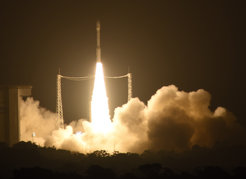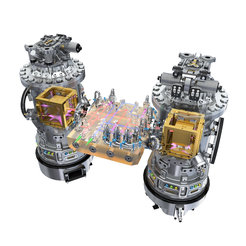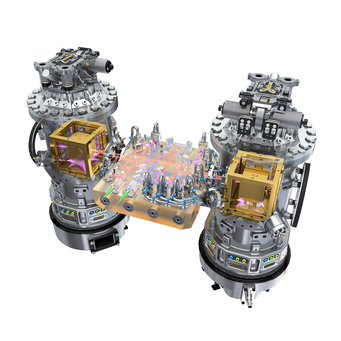Liftoff for LISA Pathfinder
Major step towards a gravitational wave observatory in space on 100th anniversary of Einstein's General Relativity
The LISA Pathfinder satellite mission lifted off earlier today on a Vega rocket from the European spaceport in Kourou, French Guiana, on its way to demonstrate technology for observing gravitational waves from space. “This mission is one large step towards a spaceborne gravitational wave detector. 96 percent of the Universe cannot be observed with existing astronomical methods. A future mission like eLISA will detect gravitational waves from space, for example from supermassive black hole binaries, and open a new window to the gravitational Universe,” says Prof. Dr. Karsten Danzmann, director at the Albert Einstein Institute and professor at Leibniz Universität Hannover.

The LISA Pathfinder (LPF) launch coincides almost perfectly with the 100th anniversary of the publication of Albert Einstein's theory of general relativity, published on 2 December 1915. The theory predicts the existence of gravitational waves, tiny ripples in space-time propagating at the speed of light, which so far have not been directly observed.
LPF will test the entirely new technologies required for to observe gravitational waves from space. At its core is a pair of free-floating, identical 46 mm gold–platinum cubes separated by 38 cm, which will be isolated from all external and internal forces acting on them except one: gravity.
“LISA Pathfinder will put these test masses in the best free-fall ever produced in space and monitor their relative positions to unprecedented precision,” says Karsten Danzmann, who also is the Co-Principal Investigator for the LISA Pathfinder Technology Package, the scientific heart of the satellite. “This will lay the foundations for future gravitational-wave observatories in space such as eLISA.”
Liftoff from Kourou
The Vega launcher lifted off at 4:04 GMT (5:04 CET). About seven minutes later, after separation of the first three stages, the first ignition of Vega’s upper stage propelled LPF into a low orbit, followed by another ignition about one hour and forty minutes into the flight.
The spacecraft separated from the upper stage at 5:49 GMT (6:49 CET). Controllers at ESA’s operations centre in Darmstadt, Germany then established control.
LPF is now in an elliptical orbit, its closest point to Earth at around 200 km and farthest point at around 1500 km. On December 6, a series of six thruster burns will commence, which will lift the apogee of the elliptical orbit higher and higher over the next five days.
Towards the Lagrange point
Finally, LPF will leave orbit around Earth entirely and drift on a transfer orbit towards the so-called Lagrangian point L1 – around 1.5 million kilometres away from Earth towards the Sun. LPF is expected to reach its operational orbit about 10 weeks after launch, on 13 February. After final checks, it will begin its six-month scientific mission on 1 March.
En route to the final orbit, the two test masses will be released from the locking mechanisms that hold them during launch and cruise. Once in orbit around L1, the final mechanisms will be unlocked and the test masses will no longer be in mechanical contact with the spacecraft.

Precise laser measurements
A laser interferometer will measure the position and orientation of the two test masses relative to the spacecraft and to each other with a precision of approximately 10 picometers (one hundred millionth of a millimetre). The construction of the precise optical measurement system was lead by the Max Planck Institute for Gravitational Physics (Albert Einstein Institute) in Hannover.
“The technology now flying on LISA Pathfinder is the result of more than a decade of scientific and engineering devolepment. It is very rewarding to see the satellite on its way into space,” says Dr. Jens Reiche the LISA Pathfinder National Project Manager at the Albert Einstein Institute in Hannover.
Data analysis in Hannover
The main scientific mission of LPF begins on March 1, 2016 and will last for at least six months. “The satellite is a complex spaceborn laboratory with which we will conduct several dense series of experiments to measure the near-perfect free fall,” says Dr. Martin Hewitson, responsible for the data analysis software developed at the Albert Einstein Institute in Hannover. These experiments will determine all non-gravitational parasitic accelerations, identify important sources of disturbances and further minimize those if necessary.
The Max Planck Institute for Gravitational Physics in Hannover is one of the leading partners in the development of the data analysis software which plays a central role in extracting the crucial information from the measurement data. For this purpose the institute has set up an operations control room in Hannover. Since an immediate data analysis is required for the configuration of follow-up experiments, scientist from the institute will also take part in the around-the-clock shifts in the European Space Operations Centre (ESOC) in Darmstadt, Germany.
LPF is an ESA mission, with the European space industry under the overall integration responsibility of Airbus DS and research institutions from France, Germany, Italy, the Netherlands, Spain, Switzerland and Great Britain as well as NASA participating.
LPF is funded through the German Aerospace Center (Deutsches Zentrum für Luft- und Raumfahrt; DLR) by the Federal Ministry for Economic Affairs and Energy based on a resolution of the German Bundestag.
Background information after the page break
The highly sensitive measurement system of LPF
Two identical cube-shaped test masses weighing about two kilograms each will be free-floating in their own vacuum canisters for the duration of the mission. They will be almost free of all internal and external disturbances and will thus allow the demonstration of the precise measurement of free-falling masses in space. A special gold-platinum alloy has been used for the masses to eliminate any influence from magnetic forces. Using ultraviolet radiation, a contact-free discharge system prevents electrostatic charge build-up on the test masses. The caging and grabbing mechanism – responsible for protecting the test masses from intense vibrations during launch, releasing them in a highly controlled setting, and capturing them as necessary – is a particular challenge in this context. A laser interferometer will measure the position and orientation of the two test masses relative to the spacecraft and to each other with a precision of approximately 10 picometers (one hundred millionth of a millimetre). In addition, there are less precise capacitive inertial sensors that also help determine their positions. The positional data is used by a Drag-Free Attitude Control System (DFACS) to control the spacecraft and ensure it always remains centered on one test mass. The actual position of the satellite is controlled through cold gas micronewton thrusters, which have the capability of delivering propulsion in extremely fine and uniform amounts. The thrust generated is in the micronewton range – this equates to the weight of a grain of sand on Earth.
Paving the way for new astronomy
LPF paves the way for eLISA, a large space observatory for the direct observation of one of the most elusive astronomical phenomena – gravitational waves. These tiny distortions of space-time were predicted by Albert Einstein and their observation requires an extremely sensitive and highly precise measurement technology. Space observatories like eLISA will measure gravitational waves in the millihertz range, that are emitted, e.g., by pairs of supermassive black holes or binary White Dwarf systems. They will complement ground-based detectors such as GEO600, aLIGO, and Virgo, which observe less massive objects at higher frequencies in the audio range. Gravitational wave observatories will probe unknown domains – the “dark side of the universe” – in concert with other astronomical methods. With eLISA, scientist for example want to research the formation, growth and merger of massive black holes. It will also be possible to further test Einstein’s Theory of General Relativity and search for unknown physics.













